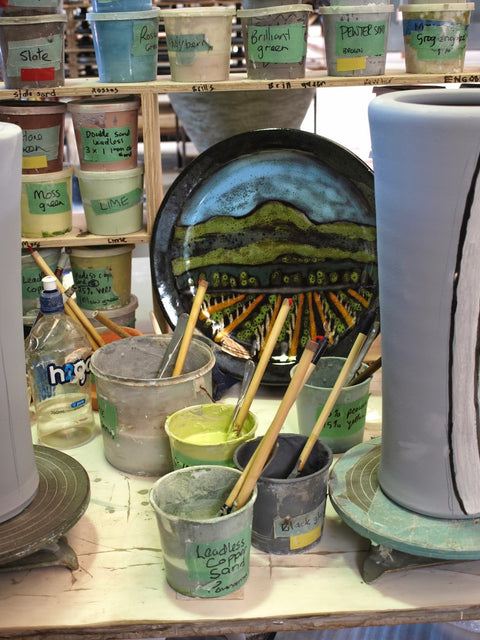
Anyone who has looked around the pottery will appreciate how reliant on water we are throughout the entire making process. Water is used to achieve the right working consistency in the clay but our greatest use is in the preparation, application and clean-up of the glazes. We take pride in our environment and make considerable effort to ensure that our activities have as little impact as possible. A major consideration for us is water management. Glaze compounds are held in suspension in water, and are either sprayed or painted onto the ceramics. In either case clean-up results in the various ingredients being carried away in the waste water. Many different chemicals are used to achieve the range of brilliant colours seen on the pottery and some of the formulations require careful handling and importantly, safe disposal. We use a tried and true method of processing the waste water that anyone who has lived in the country will be familiar with. It is essentially a three stage weir system, (four if you count the above ground tank) very similar in principle to a conventional domestic septic-tank. Whilst the glazes themselves have to be mixed with pure water (we use rain water to avoid any contamination) for cleaning we use recycled water that comes almost entirely from our filtering system.

Waste water is captured and drains into a tank where it is allowed to stand; the various materials are almost exclusively insoluable and settle to the bottom of the tank. Gradually as more water runs in, the cleaner water at the top of the tank flows over a weir and into a second and then third tank, the settling process being repeated at each stage. It always suprises me how quickly the glazes 'settle out', with the solids droping to the bottom of containers. As a result of this it is important that our decorators regularly mix their glazes to avoid them becoming too thin. However, this characteristic works in our favour when it comes to recycling, and once the water has been through the system it is quite clean enough to use again. It is in effect circulating the water through a closed loop with the only significant loss being through evaporation. Usually once a year the tanks are cleaned out and the sludge (approximately 13 cubic meters) removed and transported to Auckland for safe disposal. The original iron tank was starting to deteriorate, and to avoid potential leaks we decided to replace it. It required quite an effort to remove, but left a hole that needed only minor reshaping to accomodate the new concrete tanks.
We have been inspecting the three chambers regularly since it was installed and after several months of use it is gratifying to see that there is absolutely no sediment in the third chamber. The stage 3 water is pumped above ground where there is yet another opportunity for solids to settle, so we are very confident that everything of significance is captured before the water starts it journey through the pottery again!
- Nick C




